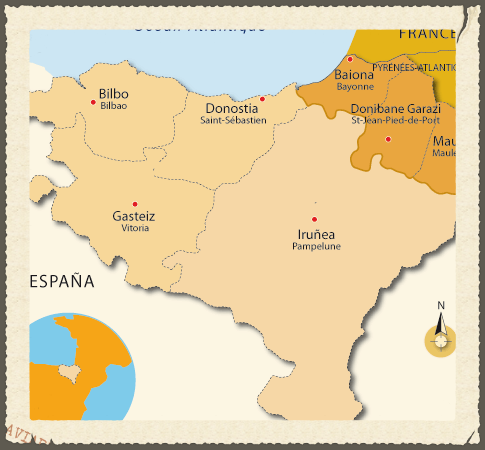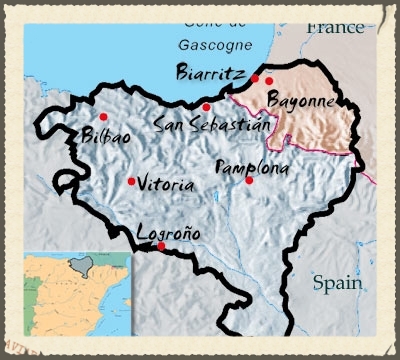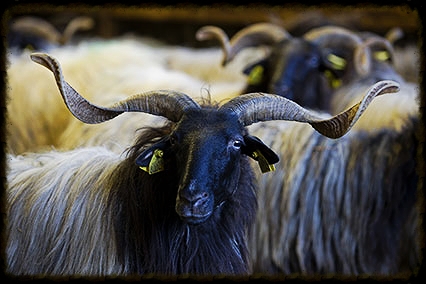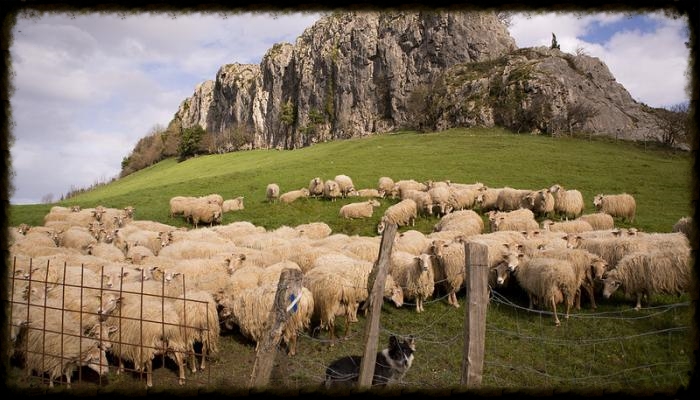In the Northern Basque Country in the Ossau Valley in Bearn and the Iraty Forest there is a great tradition of cheese making that goes back milennia. The Basques claim a culture that has remained unchanged for approximately 4000 years. Ossau Iraty(OH-soh-ear-ah-TEE) , like many cheeses of Europe, was born out the need to preserve milk and have food through the cold winter months. Sheeps' milk cheeses have always played an important economic and social role in this region.
In 1980 Ossau-Iraty Brebis Pyrenees was granted A.O.C. status. Ossau is a river and valley in Bearn and Iraty is also a river, a sprawling forest and mountain villages in France and Spain. With its oceanic climate, the Basque Country provides a mild winter with abundant rainfall that result in the grazing pastures needed for the ewes. Whether dried as hay or fresh in pasture, grass remains the foundation for feeding. It also provides the special characteristics and the aromas that are unique to the milk.
Manech and Basco-Béarnaise are the local breeds of sheep that have evolved to thrive in the Pyrenees’ terrain. In the tradition of Basque cheese making, from the end of spring to mid-October, certain herds migrate into the high mountain pastures known as estives. The migration period or transhumance remains to this day a festive and memorable occasion. At an altitude between 3000 to 6000 feet, the animals graze in pristine meadows of fragrant grass while hay is harvested on the prairies in preparation for winter.
Ewes are milked twice each day, and milk is collected daily from the farms. The estives are too distant for milk to be transported each day, so the special estives cheese is made on site, in Cayolars, traditional mountain pasture shelters (or huts) used by shepherds. Estives cheese is by necessity made from raw milk in small batches and from just one herd.
After the cheeses are made, they go through affinage for approximately 3 months before they are released to market. During that process they are washed in a brine for a short time to give some flavor. The rest of the time, they are brushed and turned periodically to maintain milk structure and shape. In addition to this treatment, the affineur must monitor the cheeses daily to ensure they are developing rind, flavor and aromas perfectly. Depending on the conditions like air flow, seasonality and occupancy, adjustments may have to be made in the cellars to enhance the quality and bring the cheeses to the pinnacle of perfection.
Ossau-Iraty is a must have. It holds its place among the greats. Its flavors and aromas are oily, olivey and nutty with just a touch of sheepiness to remind you of who's in charge. The sheep comes through in a subtle yet distinctive manner. The flavors and aromas of Ossau-Iraty transport you straight to the Basque mountains. If you've never had an out-of-body experience, this cheese will do it.
WHAT GOES WITH MY CHEESE
If you can get your hands on Jambon de Bayonne, that would be the most heavenly complement to this cheese. Made in the tradition of Iberico from Spain but milder and sweeter, this ham served alongside with crusty bread is all you need. If you can't get your hands on this, a French Saussison Sec will do.
I love Ossau-Iraty with light bodied red Rhone wine or a Rioja. If you prefer beer, the nuttiness and sweetness of a brown ale works perfectly.
This cheese is versatile and easy to love. Many times, this is the first cheese I recommend at my cheese counter, to serve at parties. It is always a crowd favorite. For those people that love Manchego and are looking to try something new, this is a wonderful discovery.
Cheese name: Ossau Iraty
Producer: Several different producers in the Basque region. Look for Istara or Onetik brand
Where: Basque Country (geographically Southwestern France)
Size: 8lbs but its available in cuts
Cheese category: Semi-hard natural rind
Milk: Raw sheep's milk (although some more modernized producers do make the cheese in pasteurized milk)
Don't forget to check out the links




